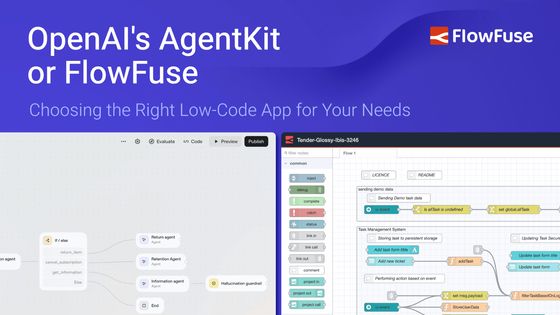OpenAI's AgentKit or FlowFuse: Choosing the Right Low-Code App for Your Needs
Understanding the key differences between AI-native agent development and edge-focused industrial automation

AI is moving fast, and with it, the tools we use to build intelligent applications. Two interesting platforms that have emerged are OpenAI's AgentKit and FlowFuse. While both offer AI capabilities, they are designed for very different purposes. Let's break down the key differences to help you decide which platform is the right fit for your needs.
OpenAI's AgentKit: For building AI agents
OpenAI's AgentKit is a toolkit for developers who want to build and deploy AI agents. Key features of AgentKit include the Agent Builder, a low-code visual environment for designing multi-agent workflows, and a Connector Registry for managing data and tool connections. It also provides ChatKit for embedding chat-based agent experiences, Expanded Evals for measuring agent performance, and reinforcement fine-tuning (RFT) to customize reasoning models. Essentially, AgentKit is for developers who are building AI-native applications and need a robust set of tools to create and manage their agents within the OpenAI ecosystem.
FlowFuse: The Bridge Between the Physical and Digital Worlds
FlowFuse, on the other hand, is built on the foundation of Node-RED, also a low-code platform. FlowFuse is specifically designed for industrial and IoT applications, with a strong focus on what's known as "the edge" – the physical world where data is generated by assets like sensors, machines, and other devices.
This is where the user's point about edge data extraction comes in. FlowFuse excels at managing and scaling fleets of Node-RED instances running on edge devices. This allows engineers to easily and securely collect data from all their industrial devices and sensors, effectively "fusing the physical with the digital."
Key Differentiators
So, how do these two platforms really differ? The first key differentiator is their core focus. AgentKit is for building AI agents that live in the digital world of applications and services, whereas FlowFuse is for building and managing end-to-end data applications that interact with the physical world through edge devices.
AgentKit, in its current form, does not have a focus on edge data extraction. Its purpose is to help you build the "brains" of an AI. FlowFuse's entire reason for being is to provide the "nervous system" that connects those brains to the real world. It's all about managing edge deployments and ensuring a reliable flow of data from the edge.
The FlowFuse AI Assistant is a powerful tool that helps engineers, even those who aren't expert coders, to build and manage their Node-RED flows. For instance, you can describe what you need in plain English and the assistant will generate the necessary code. It can also analyze a complex flow and explain what it does, making it easier to maintain. Furthermore, the assistant is a huge time-saver as it can create realistic test data and even help you build custom dashboards to visualize your data.
So, while AgentKit is a toolkit for building AI agents, the FlowFuse AI Assistant is a tool that helps you build the applications that connect to the physical world. It empowers any engineer to fuse the physical with the digital by making it easier than ever to create the logic needed to collect, transform, and act on data from the edge.
What's more, FlowFuse already supports creating AI and RAG integrations and will soon be releasing dedicated MCP nodes that greatly simplifies low-code building of AI Agents. enabling AI to work directly at the edge. This means you can create AI agents that not only process data from physical devices but also make decisions right where the data is generated — with a lot less latency due to less Cloud round-trips. This is especially important for industrial applications where milliseconds matter.
Conclusion
Choosing between OpenAI's AgentKit and FlowFuse comes down to what you're trying to achieve. If your goal is to build sophisticated, AI-powered agents for your applications and your focus is on the digital realm, then OpenAI's AgentKit is the clear choice. However, if you need to connect to, manage, and extract data from physical devices in the real world, and you want to empower your engineers with an AI assistant that makes this process easier, then FlowFuse is the platform for you.
In the end, these are two powerful but very different tools. AgentKit is for the AI developer, while FlowFuse is for the industrial engineer who wants to bring the power of AI to the edge. We're looking forward to how these technologies can be combined in future!
Ready to Connect Your Physical World?
While AgentKit is perfect for building AI agents in the digital realm, FlowFuse is built for the challenges of industrial and IoT data: managing edge deployments at scale, connecting to diverse industrial protocols, and ensuring reliable data flow from thousands of physical devices.
Whether you're monitoring production lines, building predictive maintenance systems, or implementing Industry 4.0 initiatives, FlowFuse provides the infrastructure to collect, transform, and act on data from the edge.
Start building today: Try FlowFuse free or book a demo to see how we help teams manage industrial data at scale.
Related Articles:
- What is a PLC ? History, How It Works, Types & Applications (2026)
- Five Whys Root Cause Analysis: Definition, Steps & Examples (2026)
- What is TEEP? Calculation, Benchmarks & TEEP vs OEE (2026)
- FlowFuse 2.25: Interacting with MCP Resources in FlowFuse Expert, Improved Update Scheduling, and lots of UI improvements!
- MQTT vs Kafka: Complete Comparison Guide 2026